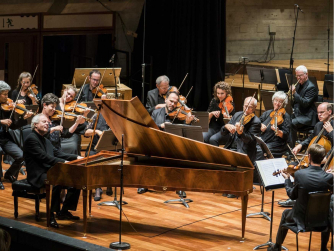Details
St Stephen Walbrook Church
39 Walbrook
City of London
London
EC4N 8BN
England
Programme
George Frideric Handel – Solomon, HWV 67: Arrival of the Queen of Sheba
Jean-Baptiste Lully – Le Bourgeois Gentilhomme: Overture and Marche pour la Cérémonie des Turcs
Johann Sebastian Bach – Orchestral Suite no.2: selection
Johann Pachelbel – Canon in D Major, P.37
Tomaso Albinoni – Oboe Concerto in D minor, Op.9 no.2
Johann Sebastian Bach – Cello Suite no.1 in G major, BWV 1007: Prelude
Jean-Philippe Rameau – Les Indes galantes: Les Sauvages
Johann Sebastian Bach – Herz und Mund und Tat und Leben (cantata), BWV 147: 'Jesu Joy of Man's Desiring'
Antonio Vivaldi – The Four Seasons: Spring
Johann Sebastian Bach – Prelude and Fugue in C major, BVW 870
Johann Sebastian Bach – Orchestral Suite no.3 in D major, BWV 1068: Air
Performers
Orchestra of the Age of Enlightenment
Programme Note
The Orchestra of the Age of Enlightenment and St Stephen Walbrook join forces to present a three-part festival of music commemorating the church’s architect, Sir Christopher Wren.
St Stephen Walbrook was the first church exclusively designed by Sir Christopher Wren of the 52 that were built by him following the Great Fire of London in 1666. Its design became the blueprint for the great dome of St Paul's Cathedral, completed three decades later. Key to the major restoration of the church completed in 1987 is Henry Moore's marble altar placed centrally under the Dome.
The festival offers a snapshot of musical life at the point of Wren’s death, three hundred years ago in 1723. This was the year of Vivaldi’s Four Seasons and the year Bach was appointed cantor in Leipzig; it was also a time of rebirth for London following outbreaks of bubonic plague and the Great Fire, with Henry Purcell at its forefront.
On Saturday 22 April the OAE presents one of their signature Baroquebusters concerts. From fellow Londoner Handel to Bach, Albinoni and Pachalbel, this engaging and interactive concert of much loved baroque favourites offers a snapshot of musical life at the end of Wren’s life, exploring why these works are still so popular today. There will be an opportunity for the audience to meet the players and learn about their historical instruments.

 Your events at Classical Events
Your events at Classical Events

